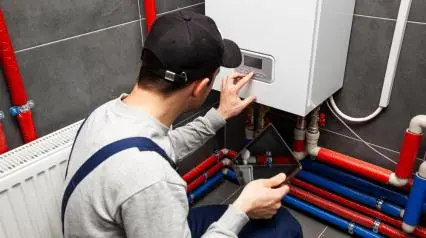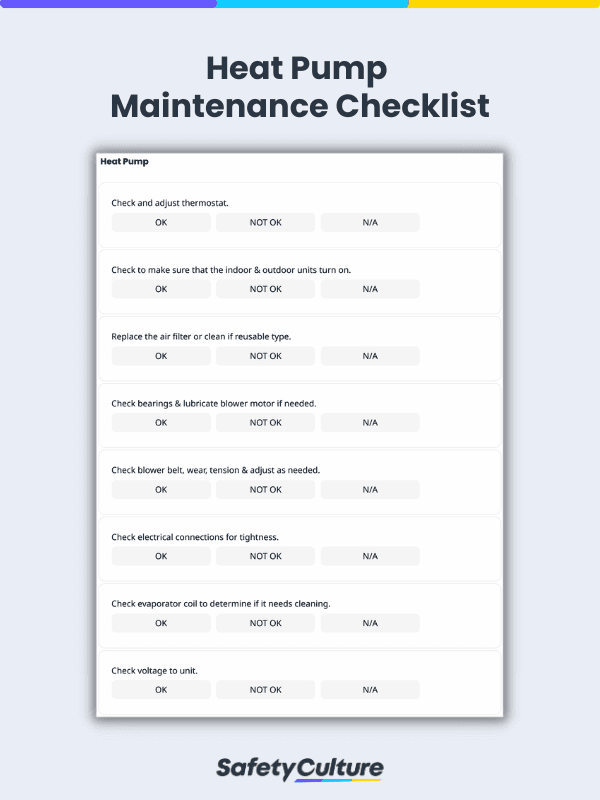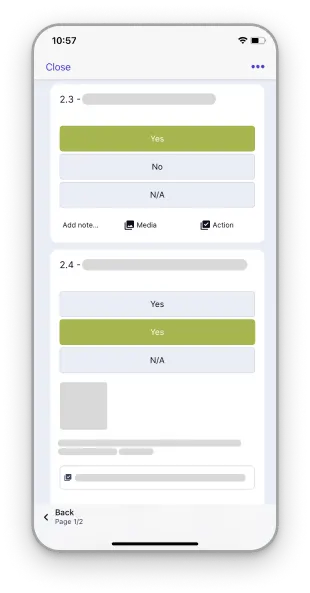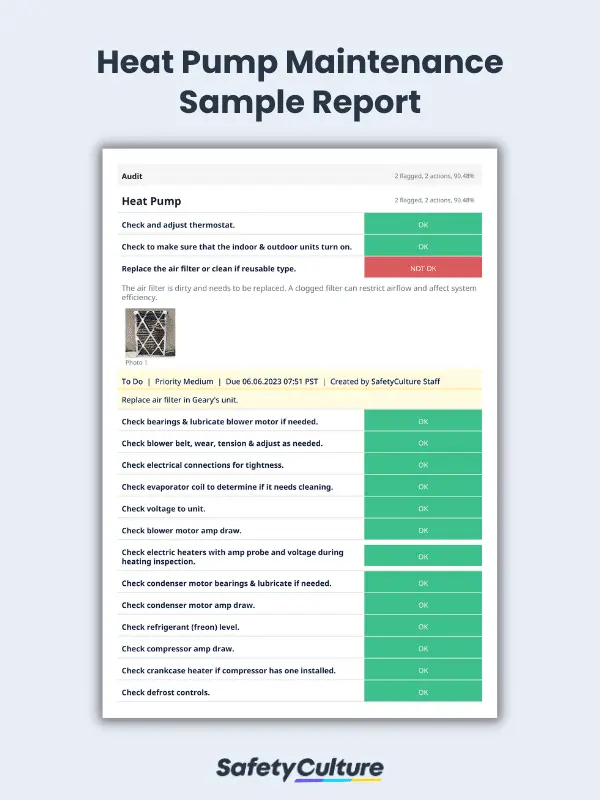What is a Heat Pump Maintenance Checklist?
A heat pump maintenance checklist outlines all the essential tasks to be conducted regularly to ensure the proper functioning, efficiency, and longevity of the heat pump system. Technicians can take advantage of this tool to inspect the heat pump’s components, determine its overall performance, and complete maintenance activities efficiently.
Benefits of Regular Heat Pump Maintenance
Regular maintenance offers several benefits for the reliability and longevity of heat pumps and overall Heating, Ventilation, and Air Conditioning (HVAC) systems.
First, it helps keep them running in optimal condition. Dust, dirt, and debris can build up in the internal compartments of the heat pump over time, hindering it from transferring heat efficiently. Regular cleaning and maintenance are key to removing these obstructions out of the way and ensuring the pump functions as intended.
Another benefit of regular heat pump maintenance is longevity, as it extends the lifespan of the equipment. Routine checks on your heat pump help detect and address minor issues early before they worsen. In turn, they minimize the risk of unexpected breakdowns and prevent costly repairs or replacements.
Lastly, this preventive maintenance procedure enhances indoor air quality and enables you to conserve energy. A clean and well-maintained heat pump operates efficiently, resulting in increased comfort at a lower energy consumption rate. Not only does it lessen your carbon footprint, but it also reduces your energy spending.
What to Include in Your Heat Pump Maintenance Checklist
Maintaining heat pumps entails a series of activities and inspection items to be completed. In the midst of this, it’s easy to skip over some items or overlook certain areas. To prevent this, HVAC technicians can utilize checklists at their disposal.
So, how do you create a heat pump maintenance checklist? Here’s a quick and easy guide on the essential tasks to add to your list:
- Check and adjust the thermostat.
- Make sure that the indoor and outdoor units turn on.
- Replace the air filter or clean it if it’s a reusable type.
- Check the bearings and lubricate the blower motor if needed.
- Examine the blower belt, wear, and tension. Adjust as needed.
- See if there’s any tightness in the electrical connections.
- Determine if the evaporator coil needs to be cleaned.
- Check the voltage of the unit.
- Check the blower motor amp draw.
- During the heating inspection, inspect the electric heaters with an amp probe and voltage.
- Check if the condenser motor bearings need lubrication.
- View the condenser motor amp draw.
- Take note of the refrigerant (freon) level.
- Check the compressor amp draw.
- Check the crankcase heater, if the compressor has one installed.
- Inspect the defrost controls.
- Test if the reversing valve operates properly.
- Check the coil temperate.
- Inspect the condensate drain and pain and inform of any discrepancies.
- Visually inspect the ductwork and note your observations.
- Check the condition of the total system and notify the customer of any discrepancies.
Seasonal Considerations for Maintenance
Aside from the standard activities mentioned above, heat pumps also require seasonal checks to keep them running optimally all year round. This section will walk you through the essentials per season to ensure your heat pump is in top shape:
Spring Maintenance Tasks
- Remove any debris, leaves, or dirt that could have accumulated around the unit.
- Trim any vegetation that could obstruct the airflow.
- Carefully inspect the unit for any signs of damage or wear, including bent fins, leaks, or loose connections.
- Check the air filters and clean or replace them if needed.
- Test if the thermostat and controls are functioning correctly and reading the temperature accurately.
Summer Maintenance Tasks
- Check the condensate drain line for dirt, algae, or debris buildup.
- Clean the line thoroughly using a mixture of water and vinegar.
- Lubricate the moving parts of the heat pump according to the manufacturer’s instructions.
- Inspect the refrigerant levels, as it can indicate a leak or an issue with the system.
Fall Maintenance Tasks
- Examine the indoor components of the pump for any blockage in the airflow.
- Get rid of any dust or debris in the coils, blower, vents, and other parts of the indoor unit.
- Test the heat pump’s heating functionality and resolve any issues found.
- Check the ductwork for any signs of leak or damage.
- Seal any gaps or cracks in the ductwork using duct sealing materials.
Winter Maintenance Tasks
- Inspect the air filters and have them replaced when needed.
- Clear any snow, ice, and debris buildup in the outdoor unit.
- Perform a thorough inspection to detect any underlying issues and give any necessary repairs and replacements.
Safety Precautions
Safety is paramount when performing heat pump maintenance to avoid injuries, accidents, and other hazards. Here are a few precautions to consider before and during the process:
Before Maintenance
- Isolate the power supply to the heat pump system by either shutting off the electrical power at the circuit breaker or disconnecting the switch to avoid accidental electrical shocks.
- Receive proper training on heat pump systems, maintenance procedures, potential hazards, and safety protocols.
- Prepare the necessary tools and equipment for maintenance tasks (e.g., insulated tools for electrical work).
- Read and understand the manufacturer’s guidelines, recommendations, and instructions for safe equipment use and maintenance.
During Maintenance
- Wear appropriate Personal Protective Equipment (PPE) for the specific tasks involved, ranging from safety glasses and gloves to hearing and respiratory protection.
- If multiple technicians are working on the same system, observe proper lockout/tagout procedure to prevent accidentally activating equipment during maintenance.
- When working on heat pump systems, especially in confined spaces, ensure adequate ventilation through fans or other equipment.
- Carry out safety practices for handling hazardous substances (e.g., refrigerants), using ladders, and similar activities.
Heat Pump Maintenance FAQs
It’s recommended to service and maintain your heat pump on an annual basis, ideally twice a year in the spring and fall. Having a regular maintenance schedule is vital for ensuring optimal performance and fixing potential problems that could result in major repairs or replacements.
Listed below are some common indicators that your heat pump requires maintenance or repair:
- Insufficient heating or cooling
- Inconsistent airflow from the vents
- Banging, grinding, squeaking, or other strange noises
- Frost or ice buildup
- Persistent unpleasant odors
- Irregular or more frequent cycling periods
- Issues with the thermostat (e.g., inaccurate readings, unresponsive controls)
Yes, regular heat pump maintenance plays an essential role in lowering energy consumption. This activity allows heat pumps to operate more efficiently and, as a result, reduces energy usage. According to the US Department of Energy, well-maintained heat pumps have helped users save 10-25% of energy compared to neglected heat pump systems.




